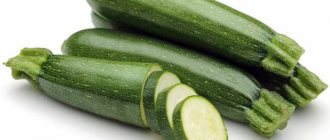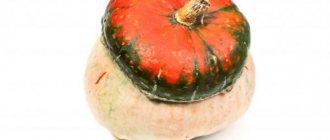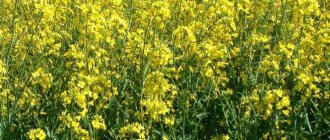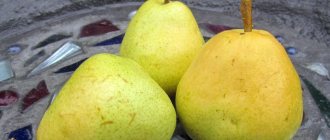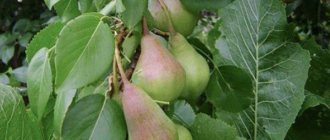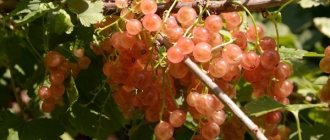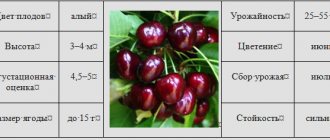History of creation
Tomatoes, which have very large and fleshy fruits, were bred in the USA. In a country where grilling meat and vegetables is well developed, there was an urgent need to create tomatoes with low-juiciness, fleshy fruits.
The creator of these plants is considered to be Johan Munstr, a farmer and vegetable grower. Munster received an award from the government for his brainchild. Today, there are dozens of varieties and hybrids of beef tomatoes known in the world, which are grown in greenhouses and open ground.
Large tomatoes
Interesting! Translated from English, the word “beef” can be translated as beef, steak.
The name fully characterizes the structure of the fruit of this type of tomato. The flesh of the beef fruit is red, fleshy, with many seed chambers. At the same time, the seeds are small and there is very little juice inside the fruit. When cut, the structure of a beef tomato resembles a piece of marbled beef.
Fleshy tomato in section
Tomato Big Beef F1
The mid-early Dutch hybrid is distinguished by bushes up to two meters high, on which fruits weighing up to one kilogram ripen within 100–110 days after germination. If many clusters are removed from the bush, the fruit can reach greater weight.
Description of the fruit:
- slightly ribbed flat-round shape;
- the average fruit weighs 250–380 grams;
- the flesh is fleshy and juicy;
- the multi-chambered fruit has six nests;
- ripe red tomatoes have a sweet, slightly sour taste;
- rich in lycopene, provitamin A, sugars;
- suitable for industrial cultivation because they have an excellent presentation;
- tolerate transportation well;
- stored for up to twenty days;
- used fresh and fried, for the preparation of canned salads, tomato paste, ketchups, purees, juices.
Big Beef F1 tomatoes were first registered in 2001. They can be grown indoors in any region.
Dutch tomato varieties for greenhouses and open ground
Variety characteristics:
- after planting seedlings, the ripening period is about seventy days;
- from one square meter with good care you can collect about nine kilograms of fruit;
- the bush is formed into one stem;
- no more than three bushes should be planted per square meter;
- the plant requires pinching and tying to stable supports.
sown for seedlings in March . In May, when the soil has warmed up well, the plants can be planted in the greenhouse.
Varieties and varieties
Below are the main characteristics of varieties and hybrids of fleshy tomatoes that are popular among domestic gardeners.
Big Beef 1
A tall hybrid intended for planting in a greenhouse. Depending on the height of the greenhouse, the plant stem is pinched at 180-250 cm. The tomato is resistant to temperature changes and fusarium.
The harvest ripens 110-115 days after seed germination. The fruits are red, round, weighing 270-350 g. The pulp is dense, sweet and aromatic.
Negro Beef
A greenhouse tomato reaching a height of 250 cm. Its distinctive feature is large, flat-round, chocolate-colored fruits. The average weight of a tomato is 300 g. You can get fruits weighing up to 600 g if you leave 1-2 ovaries on the flower cluster.
The taste of tomatoes is delicate and sweet. The pulp is juicy and aromatic. The fruit has a thin skin, so Negro Beef is especially tasty in salads.
Bull's heart
A productive variety well known to Russian gardeners, which can easily be classified as “beef”.
The plant is powerful, with a height of 130 to 180 cm. Each bush ripens from 5 to 8 kg of tomatoes. The ripening period is medium-late. The shape of the fruit resembles a heart, weight from 220 to 700 g. The tomato pulp is dense, very sweet, with low juiciness.
On a note! On sale are Ox's Heart seeds with red and pink fruits.
Big Boy
Tall (stem length from 1.5 to 1.8 m) early ripening tomato (115-120 days from sowing). Suitable for cultivation in open and closed ground.
The bush ripens up to 5 kg of large pink heart-shaped fruits, weighing up to 400 g. The pulp is multi-chambered, sweet.
Beef Master
The hybrid plant has a late ripening period (125 days from sowing), therefore it is grown only in greenhouses. The tomato is characterized by:
- tall (200-240 cm);
- large-fruited (fruit weight more than 500 g);
- resistance to diseases (TMV, Alternaria, Fusarium);
- productivity (more than 10 kg per 1 sq. m).
Description of the Infinity variety
The plant is recommended for cultivation in open ground in the North Caucasus, Volga and Central regions, and in greenhouse conditions throughout Russia.
The medium-branched hybrid is distinguished by non-standard bushes up to 1.9 meters high, resistance to a range of diseases and fruit ripening 90–110 days after the seedlings sprout. It is not affected by crown and root rot, Alternaria blight, and tobacco mosaic. The bushes need staking and removal of lateral shoots. They are formed into one stem.
Description of the fruit:
- weight from 240 to 270 grams;
- deep red, round, large;
- with smooth thin skin;
- stored in cool conditions for a long time and transported well;
- contain a lot of sugars and vitamin C;
- can be eaten fresh, in pickled salads and processed.
The best varieties of tomatoes for the greenhouse
From one square meter you can harvest up to 17 kilograms of Infinity tomatoes.
Advantages of a hybrid:
- high stress resistance;
- excellent yield;
- immunity to most fungal and viral diseases;
- wonderful taste;
- fruit resistance to cracking;
- heat tolerance;
- good transport tolerance.
The plant does not tolerate cold temperatures below +15 degrees , so in regions with cold climates it is recommended to grow it under film.
Fruit beef tomatoes
A special group of large-fruited tomatoes that have a pronounced fruity note in taste. The fruits from these plants are especially tasty fresh in salads and on sandwiches.
Examples of fruit tomatoes:
- Safari (early, persimmon-like fruits, weighing 300 g);
- Retro (early, red fruits, up to 400 g);
- Balance (early, orange tomatoes, weighing 360 g).
Among the tastes most characteristic of such tomatoes are: orange, melon, strawberry, watermelon.
Beef tomatoes: characteristics and features
The term “beef” means that the seeds will grow into plants with fleshy, multi-chambered, large fruits. The content of juice and seeds in tomatoes is minimal. Beef tomatoes have the following qualities:
- fetal weight from 150 to 600 g;
- the presence of more than 4 small seed chambers;
- the pulp is dense, holds its shape well when cut into circles or slices;
- Beef tomato can be stored for no more than 5–7 days.
Tomatoes have a rich, sweet taste. Some varieties have fruity notes in taste. The color of the skin of the fruit can be different: red, pink, yellow, chocolate.
Advantages and disadvantages
The main advantage of this group of tomatoes is their amazing taste and high percentage of pulp. Due to the increased content of dry matter, such tomatoes contain several times more vitamins, minerals, and sugars than ordinary fruits.
In addition, many gardeners note consistently high yields of beef tomatoes.
The disadvantages include:
- low shelf life due to thin skin;
- tendency to cracking;
- plant requirements for soil fertility and fertilizing.
The best varieties of beef tomatoes
The varieties listed below are among the most famous. However, the situation does not stand still; new varieties continue to be developed. Domestic agricultural companies are intensively experimenting with plant growth, fruit size and their characteristics, so every year a beginner has an increasingly larger assortment before his eyes.
Big Beef
In Europe, large-fruited varieties began to be cultivated and bred more often, so today you can find many varieties of foreign origin on the market. Big Beef is a Dutch variety designed for greenhouse cultivation. Thanks to fertilizing and lighting, the harvest can be obtained within 100 days. The weight of the fruit is 200 - 220 g, the bush is interdeterminate, formed by pinching and pinching. The tomatoes are flattened horizontally, with slight ribbing visible on top. The hybrid is resistant to diseases, and the yield reaches ten kilograms per bush.
Mikado
Despite the Japanese name, the variety is exclusively Russian, fresh, registered in 2015. An interdeterminate bush of a greenhouse nature, but in the southern regions it is safely grown in open ground, easily achieving a marketable fruit weight of 300 g, while the average yield is 5 - 6 kg. It is compensated by a wonderful taste, grainy, juicy pulp. In a transverse section, about 6 seed chambers are usually observed. The color of the classic Mikado is pinkish-red, but varieties with bright red, yellowish and even blackish skin when ripe have already been developed.
Mazarin
The large-fruited variety is a tall variety, which in greenhouse and open ground conditions grows up to two meters. To do this, he needs a competent garter for support. In response to proper care, the tomato will be pleased with its high yield - up to 14 kg per bush. Such high rates can be achieved due to the parameters of the tomatoes themselves: they are very large, after 120 - 130 days they reach a weight of 500 - 700 grams. The shape of the fruit is attractive: some compare it to strawberries, but it would be more accurate to say that it is heart-shaped or looks like an inverted drop. The flesh has a sweetish taste, and the skin allows the tomatoes to sit for a while, although not as long as many medium-sized tomatoes.
Asia F1
Since a characteristic feature of large-fruited tomatoes is late ripening, breeders are always fighting to speed up this process. Turkish specialists have succeeded in this, developing a variety that turns red just 2.5 months after the start of germination. Despite this fact, in central Russia, breeding is possible in greenhouses. But the southern regions, especially the Black Sea region, allow open ground: here the high level of solar insolation helps the tomato ripen. The fruits themselves weigh 300 - 500 grams, evenly colored, red, round, with barely noticeable smooth ribs.
Grandma's gift
Russian breeders registered the variety back in 2010, and since then it has been popular for its taste. Growing indoors in greenhouses and greenhouses produces bushes with a height of 1.5 - 1.8 m. Proper pinching minimizes side shoots, and all the strength goes into the tomatoes themselves, causing them to fill up to a weight of 150 grams, although this is not the limit for the variety. The yield is approximately 10 - 12 kg per square, and resistance to traditional pests makes life easier for the owner.
Scorpion
Another Russian variety. Breeders claim that they tested germination in Siberian conditions - of course, in greenhouses. Considering the fast ripening speed of 50 - 65 days from the moment the sprouts appear, you can believe this, but make a reservation that in the case of a small number of sunny days, the tomatoes will have to be supplied with artificial lighting. With sufficient insolation, the bush grows up to 1.8 m, and by branching it into 2 stems, you can achieve maximum yield - again, in the presence of nutrients. Flat-round tomatoes weighing 400 - 500 grams have a thick skin and a long shelf life.
Amana Orange
The American hybrid is notable for its productivity: if all agrotechnical practices are followed, it is possible to harvest up to 17 kg per 1 square meter. m area. To do this, 2 stems are formed in the bush. The fruits are bright yellow, turning orange, with an average weight of 0.3 - 0.4 kg, but there are many cases where it was possible to increase this figure to a kilogram. There are 6 nests in the fruit; they have a slightly flattened shape. The best results can be achieved with greenhouse cultivation.
Big Sasher F1
Another Turkish variety, this time black. The average ripening time could not be combined with the large weight of the fruit: the average is 150-170 g, which is the lower limit for beef varieties. True, the pulp has a good sweetish taste and a high dry matter content. As tomatoes ripen, they change color from green to yellow to red, and then darken almost to black, although not completely. The advantage is the high uniformity of the resulting harvest, which makes it possible to roll Sasher into jars, although this is rare with beef. This task is also facilitated by simultaneous maturation.
Cardinal
Ripening time is average. The fruits are large, average weight - 500 g, heart-shaped, cone-shaped at the end. Productivity up to 15 kg per square. The first fruits can be very large - up to a kilogram, but the subsequent ones are slightly smaller in mass. The height of the medium-determinate bush is about 1.5 meters; it is recommended to divide it into two stems to improve yield. In addition to being consumed fresh, tomatoes are sometimes used for making soups, as well as pureed. Their skin is too thin to be preserved whole.
Mammoth
Bred in Russia, included in the State Register in 2007. The breeders' task was to develop a variety that was undemanding to growing conditions. The bush is interdeterminate, requires obligatory pinching, can be grown in open ground in the southern regions without problems, unlike other varieties, it is less demanding on watering. Drought resistance makes it extremely unpretentious. The downside is that the yield is not very high - about 5 kg per square. Moreover, the fruits themselves are about a quarter of a kilogram, fleshy, juicy, with a pleasant taste.
Bear Paw
The variety is good for the appearance of the fruits, which are not only for home consumption, but are also readily sold out. The fruit has no ribs - it is round, sometimes slightly flattened, almost spherical. The color of the skin when ripe is classic red, with a slight hint of pink. The fruits ripen evenly; 6–7 ovaries are formed on the cluster. Ripening takes about 4 months, harvesting in greenhouses continues until cold weather, in open ground in the southern regions - until about the end of September. The weight of the fruit is up to 300 g, and the dense sweet and sour pulp contains a fairly large number of seeds for beef.
Bull's heart
It is unlikely that anyone knows the varieties of this variety. At markets and agricultural fairs there is always a line for it, both for fruits and seeds. Ox heart is a classic beef: it has a pinkish color, juicy flesh with a characteristic sweet taste, which allows it to be used in salads and for stuffing, in a word, fresh. The shape of the fruit actually slightly resembles a heart, and the epithet “bull” was probably born as an allusion to the large size of the fruit (up to 400 g), because it was one of the first purely salad large fruits. The bush is grown in open ground up to the Belgorod - Volgograd line. To the north, it is better to plant tomatoes in greenhouses, this way you can extend the harvest period.
Russian size
It is recommended for cultivation in greenhouses, since the late ripening period allows you to fully enjoy the harvest even when cold weather sets in outside. Greenhouse cultivation allows you to extend the period of fruiting until the onset of the first frost. The fruits of the variety are especially large, easily reaching a weight of 600 g, and under favorable conditions and proper formation of the bush, even more - 800 - 900 g. Ripening is uneven, so it is convenient to pick tomatoes from time to time and serve them on the table - they are a source of vitamins and other useful substances. The bushes are highly resistant to diseases.
King of the Giants
The green part of these bushes is faster than other interdeterminants in terms of speed and scale of growth. In greenhouse conditions, with proper staking and pinching, it can reach a height of 4 m. Gardeners rarely allow such dimensions, since the root system does not cope well with supplying nutrients to such a large plant, and the ripening time of fruits increases. Usually tomatoes are pinched at a height of 1.8 - 2 m, but the side shoots are nurtured, on which ovaries also form. The average fruit weight is about 400 g. The lower fruits are larger than the upper ones and ripen faster. Some lovers bring the weight of tomatoes up to a kilogram, which is a record even for beef varieties.
Features of cultivation and care
Sowing “meat” tomatoes for seedlings and growing until planting in the ground does not differ from the methods of cultivating ordinary tomatoes. But the formation and feeding of plants has its own nuances.
Important! Beef tomatoes require free placement in the garden. To form large fruits, a tomato requires an area of 0.5 square meters. meters.
Formation
Most varieties with large fruits do not have restrictions on stem growth. The vegetable grower himself determines the height of the bush by pinching the top of the tomato at the desired level.
In a greenhouse, the plant is formed into 1 stem, removing all lateral shoots. Stepchildren are cut with scissors or pinched (you cannot cut them off, damaging the skin of the stem!) while they are short.
In open ground, a tomato bush can be formed into 2-3 stems, leaving the first and second stepson at the bottom. In order for the plant to be better illuminated and ventilated, the stems are tied to several stakes or a net, like a fan.
Top dressing
To obtain large and sweet tomatoes, plants need to be fed every 2 weeks. It is better to use balanced mixtures of mineral fertilizers intended for tomatoes: Fertika, OMU, Hera, Agricola.
Among the folk recipes that are suitable for tomatoes:
- infusion of manure, ash, banana skins, grass and bread;
- solution of iodine, ammonia, boric acid (spraying);
- extract from vermicompost.
Spraying shoots with a spray bottle
Variety Big Boy
Indeterminate, mid-early variety with a powerful bush up to 150–180 cm high . Designed for greenhouse cultivation, where it is formed into two or three stems. The bushes need to be tied up and pinched.
Large, bright red fruits can reach a weight of 300 to 500 grams . They are distinguished by their oval-heart-shaped shape, fleshy pulp and pleasant tomato-sweet taste. They have virtually no chambers or seeds. When cut, tomatoes do not fall apart, so they are great for canning in slices. They can be used to prepare sauces, juices, and salads.
With proper agricultural technology, one bush can produce up to seven kilograms of fruit. If there is insufficient nutrition, they will take a long time to ripen on the bush.
Big Boy tomato seedlings are ready for planting in the ground 50–60 days after germination. In a greenhouse, plants are planted with a distance between rows of 80 to 100 cm, and between bushes - 60–70 cm. Since the bushes are tall, many gardeners grow them on a trellis.
Description and characteristics of Mazarin tomatoes
Pests and diseases
Most modern plants are, to one degree or another, resistant to major tomato diseases. Large-fruited varieties, having thin skin, are prone to cracking. An infection penetrates into the wounds, which leads to the development of rot. To avoid cracking, take the following measures:
- reduce watering during the final fruit filling phase;
- remove cracked tomatoes in a timely manner and ripen them indoors, sprinkling the cracks with salt;
- spray the plants with antifungal drugs.
Tomato care
To get large fruits of beefsteak tomatoes, you need to provide them with proper care. Plants are resistant to external conditions, but if these conditions are unfavorable, harvests will be poor.
How to care for plants:
- Stepsonning. A very important procedure for beefsteak varieties. All excess side shoots and leaves must be removed. It is recommended to leave no more than 4-5 ovaries on one branch. Otherwise, the plant simply will not support the weight of the fruit.
- Watering. Water the bushes at the roots. One bucket of water for one plant twice a week. The condition of the soil must also be taken into account. The next watering is carried out if the top layer has already dried.
- Fertilizer. Beefsteak tomatoes need more feeding than regular varieties. There should be 2 times more potassium salts in the fertilizer than nitrogen components. Fertilizing is applied once a month.
Potassium fertilizers have a positive effect on fruit growth. Nitrogen improves the growth of green shoots and leaves. That is why it is important to increase the amount of potassium in the feeding.
Big Beef, Pink and Rosebeef varieties ripen unevenly. Therefore, you can collect and eat fresh tomatoes for 2-3 months, from the end of June to the beginning of September.


